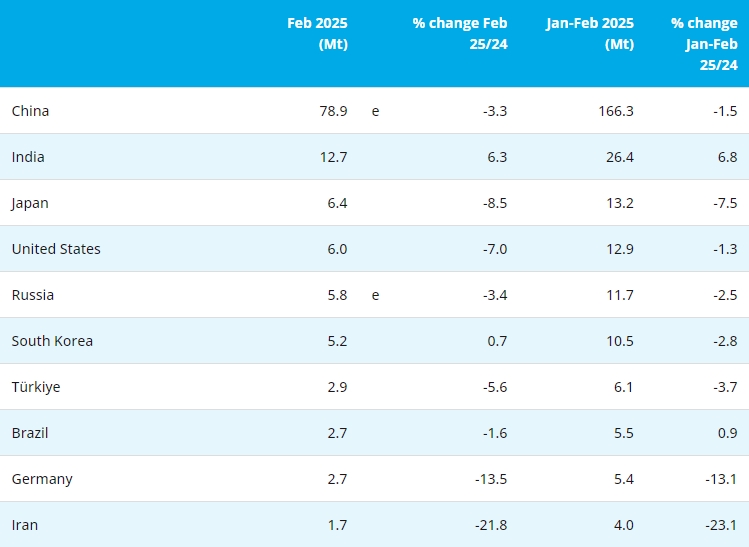[ferro-alloys.com]Seaborne metallurgical coal prices have fallen sharply since China moved to temporarily halt Australian coal imports in early October as the implied surplus weighing on the global market in the fourth quarter is priced in.
Chinese steelmakers have been obliged to quickly seek alternative supply, and some are trying to resell their cargoes.
However, the spot availability of alternative origins is low, forcing Chinese steelmakers to use more expensive domestic coking coals, eroding their profit margins in the process.
Alternative seaborne origins such as Canada, the US, Mozambique, Russia and Mongolia are mostly overbooked, or in short supply. In addition, it takes around 45 days to ship coal from the US to northern China, which would result in late December or January arrivals, and 21 days from Canada. For Chinese buyers seeking spot cargoes to cover immediate needs, this is too long to wait.
From Russia and Mozambique, spot availability is understood to be low at present.
The one bright spot is Mongolia, whose coal quality is a good substitute for generic hard coking coal. The landlocked country has been increasing exports to China and is now sending more than 1,000 trucks a day laden with coal.
Mongolian #5, the most frequently traded brand, has been offered at around Yuan 1,300/mt ex-stock Jingtang, equating to $163.42/mt after accounting for port fees, taxes and exchange rates. Mongolian met coal has accounted for 23% of China's imports to date in 2020, according to China Customs data, down sharply from an average of 42% over the last three years. This is due partly due to border closures during the pandemic lockdown.
When the restrictions on Australian coal imports were announced, many Chinese mills expressed concern that domestic coking coal and coke prices would increase and squeeze steel margins. Finished steel prices recovered strongly after the Golden Week holiday, but domestic hot-rolled coil and rebar margins were just $29/mt and $26/mt, respectively, on Oct. 22, both easing from a week earlier, S&P Global Platts data showed. Margins also remain under pressure from relatively high iron ore prices.
"Fewer imported coking coal cargoes mean more price support for domestic coke." a domestic coke trader said, adding that a fifth round of price increases of Yuan 50/mt ($7.50/mt), totaling Yuan 250/mt, is expected soon.
QUALITY CONCERN
In addition to limited alternative import options, quality concern is another factor that could hurt steelmakers in China.
Australian premium hard coking coal has a number of sought-after attributes, including high coke strength after reaction, low sulfur and low ash, which only a few countries can offer.
A number of steelmakers told Platts that while 100% self-sufficiency remains a possibility, the absence of high-quality Australian grades to blend would reduce production efficiency in the steelmaking process, leading to lower profit margins.
The painful reality is that the import price arbitrage is at a record $65/mt, a situation which Chinese end-users are unable to take advantage of.
Platts assessed the CFR China equivalent of Shanxi PLV at $190.40/mt Oct. 21, much higher than the Platts PLV CFR China assessment at $125/mt on the same day. This means the domestic-seaborne price spread was $65/mt, with seaborne material the much cheaper option -- it is the widest arbitrage since Platts launched the PLV assessment in September 2016.
However, even before the ruling on Australian material, there was little opportunity to benefit as import quotas had been largely used up.
In a scenario where China will receive no Australian met coal over October-December, an estimated 6 million mt of Australian met coal will need to find another home in the global market. The analysis considers the official reporting of year-to-date import arrivals from Australia at 31.6 million mt, and Platts estimated volume for September using spot trade data. It is estimated that China could conclude 2020 with a total of 35 million mt of Australian met coal imports should the import ban remain through to year end.
China has already imported more Australian met coal to date in 2020 than in did in full year 2019, 2018 or 2017. Based on China Customs data, China imported 31 million mt of met coal from Australia in 2019, and imports have averaged 30 million mt/year over the past three years.
As a result, market participants are hopeful for a quick resolution to an issue that ultimately does not benefit either side.
(S&P Global Platts)
- [Editor:王可]



 Save
Save Print
Print Daily News
Daily News Research
Research Magazine
Magazine Company Database
Company Database Customized Database
Customized Database Conferences
Conferences Advertisement
Advertisement Trade
Trade












 Online inquiry
Online inquiry Contact
Contact

Tell Us What You Think